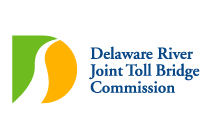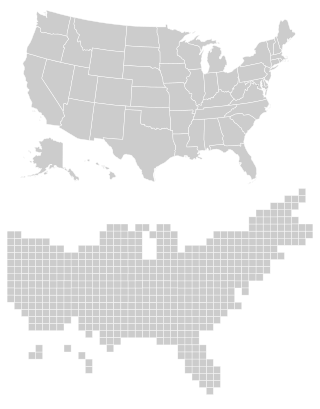
Interstate 95 (I-95) is the main north–south Interstate Highway on the East Coast of the United States, running from U.S. Route 1 (US 1) in Miami, Florida, north to the Houlton–Woodstock Border Crossing between Maine and the Canadian province of New Brunswick. The highway largely parallels the Atlantic coast and US 1, except for the portion between Savannah, Georgia, and Washington, D.C., and the portion between Portland and Houlton in Maine, both of which follow a more direct inland route.
E-ZPass is an electronic toll collection system used on toll roads, toll bridges, and toll tunnels in the Eastern United States, Midwestern United States, and Southern United States. The E-ZPass Interagency Group (IAG) consists of member agencies in several states, which use the same technology and allow travelers to use the same transponder on toll roads throughout the network.

The Delaware River Joint Toll Bridge Commission (DRJTBC) is a bistate, public agency that maintains and operates river crossings connecting the U.S. states of Pennsylvania and New Jersey. The agency's jurisdiction stretches roughly 140 miles (230 km) along the Delaware River from Philadelphia and Bucks County in southeast Pennsylvania and then north through the Lehigh Valley and to Pennsylvania-New York state border.

The National Popular Vote Interstate Compact (NPVIC) is an agreement among a group of U.S. states and the District of Columbia to award all their electoral votes to whichever presidential ticket wins the overall popular vote in the 50 states and the District of Columbia. The compact is designed to ensure that the candidate who receives the most votes nationwide is elected president, and it would come into effect only when it would guarantee that outcome.

The drafting of the Constitution of the United States began on May 25, 1787, when the Constitutional Convention met for the first time with a quorum at the Pennsylvania State House in Philadelphia, Pennsylvania to revise the Articles of Confederation. It ended on September 17, 1787, the day the Frame of Government drafted by the convention's delegates to replace the Articles was adopted and signed. The ratification process for the Constitution began that day, and ended when the final state, Rhode Island, ratified it on May 29, 1790.

The Mount Vernon Conference was a meeting of delegates from Virginia and Maryland held at Mount Vernon on March 21–28, 1785, to discuss navigational rights in the states' common waterways. On March 28, 1785, the group drew up a thirteen-point proposal to govern the rights of both states on the Potomac River, Pocomoke River, and Chesapeake Bay. Known as the Mount Vernon Compact and formally titled as the Compact of 1785, this agreement not only covered tidewater navigation but also extended to issues such as toll duties, commerce regulations, fishing rights, and debt collection. Ratified by the legislature of both states, the compact helped set a precedent for later meetings between states for discussions into areas of mutual concern.
The Water Resources Development Act of 1999, Pub. L.Tooltip Public Law 106–53 (text)(PDF), was enacted by Congress of the United States on August 17, 1999. Most of the provisions of WRDA 1999 are administered by the United States Army Corps of Engineers.

The Susquehanna River Basin Commission (SRBC) is a federal-interstate compact commission created by the Susquehanna River Basin Compact (Pub. L. 91-575) between three U.S. states: (Pennsylvania, New York, and Maryland), and the federal government, and signed into law by President Richard Nixon on Christmas Eve 1970 to be effective 30 days later on January 23, 1971.

The Northeast Interstate Dairy Compact was an Interstate compact among the six New England states, agreeing to support the farm price of milk at a higher level than under federally mandated minimum prices in the region.
1776 is celebrated in the United States as the official beginning of the nation, with the Declaration of Independence of the Thirteen Colonies from the British Empire issued on July 4.
The Nurse Licensure Compact (NLC) is an agreement that allows mutual recognition (reciprocity) of a nursing license between member U.S. states. Enacted into law by the participating states, the NLC allows a nurse who is a legal resident of and possesses a nursing license in a compact state to practice in any of the other compact states without obtaining additional licensure in the remote states. It applies to both registered and practical nurses and is also referred to as a multi-state license.
Radioactive waste is generated from the nuclear weapons program, commercial nuclear power, medical applications, and corporate and university-based research programs. Some of the materials LLW consists of are: "gloves and other protective clothing, glass and plastic laboratory supplies, machine parts and tools, and disposable medical items that have come in contact with radioactive materials". Waste is generally categorized as high level waste (HLW) and low-level waste (LLW). LLW contains materials such as irradiated tools, lab clothing, ion exchanger resins, animal carcasses, and trash from defense, commercial nuclear power, medical, and research activities. These materials usually have radioactivity that have short half lives—from ranges of multiple days to several hundred years. In 1990, 1.1 million cubic feet of LLW was produced. Currently, U.S. reactors generate about 40,000 cubic meters of low-level radioactive waste per year, including contaminated components and materials resulting from reactor decommissioning.

The Interstate Commission on the Potomac River Basin (ICPRB) is an agency composed of commissioners representing the federal government, the states of Maryland, Pennsylvania, Virginia, West Virginia, and the District of Columbia. The ICPRB mission is to enhance, protect, and conserve the water and associated land resources of the Potomac River basin and its tributaries through regional and interstate cooperation.
Alabama v. North Carolina, 560 U.S. 330 (2010), was an original jurisdiction United States Supreme Court case. It arose from a disagreement between the state of North Carolina and the other members of the Southeast Interstate Low-Level Radioactive Waste Management Compact over the funding for a joint project. Eight states had formed the compact in 1983 to manage low-level radioactive waste in the southeastern United States. In 1986, North Carolina was chosen as the location for the regional waste facility, and it asked the other states for funding to help with the project. The project stalled and was eventually shut down, despite North Carolina receiving $80 million from the other states. After the project's demise, the other states demanded their money back, but North Carolina refused to repay them, leading to this case.
The Eastern States Multi-state Council is an interstate compact between seven northeastern states in the United States to coordinate the rollback of economic restrictions implemented by the state governments in response to the COVID-19 pandemic.

The 119th United States Congress is the next meeting of the legislative branch of the United States federal government, composed of the United States Senate and the United States House of Representatives. It is scheduled to meet in Washington, D.C., from January 3, 2025, to January 3, 2027, during the final weeks of Joe Biden's term. The elections of November 2024 will decide control of both houses.
There is ongoing legal debate about the constitutionality of the National Popular Vote Interstate Compact in the United States. At issue are interpretations of the Compact Clause of Article I, Section X, and states' plenary power under the Presidential Electors Clause of Article II, Section I.








